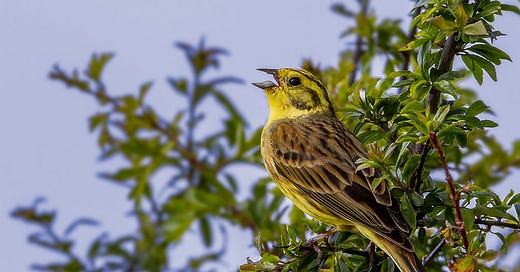‘A-little-bit-of-bread-and no cheeeeeese’ is one of the best-known bird mnemonics, and hard to beat as a rhythmic reminder of the yellowhammer’s tireless song.
This is a real summer sound. Yellowhammers sing later than many species, right though into August, and so this repetitive phrase may be etched into the memory along with butterflies, tall grasses and school holidays.
As Mark Cocker writes in Birds Britannica:
“We do not so much as listen to yellowhammer, as hear it subconsciously, and by sheer repetition it triumphs over us to create an impression far greater than louder or more beautiful bird sounds.”
Somewhat less distinctively, yellowhammers also emit abrupt contact calls to keep in touch with one another. Once you’re familiar with these noises they can give away the birds’ presence ahead of you along a hedgerow, or as they fly.
(Listen out for the green woodpecker in the background of this recording too).
Like the linnet and the stonechat, yellowhammers are birds of open areas. In the West of Britain they are a familiar sight on coastal clifftops, where the bright yellow head of the male is often to be found atop a gorse bush.
In lowland areas they are often birds of the arable, and here their fortunes are more closely tied to changes in human activity. Like most other farmland species, their numbers have dropped in recent decades, as farming practices have intensified into bigger fields, fewer insects and less spilt grain.
Fortunately their decline has not been as sharp as those of grey partridge, lapwing or tree sparrow, and yellowhammers can still be found in many places where there are hedgerows, or scruffy, scrubby grassland.
The canary-yellow head is an easy giveaway to the male. The females have much less yellow and might be taken for other kinds of bunting or sparrow. But both sexes have a rusty-coloured rump, which shows as they fly, and sometimes while they’re perched.
Media credits:
Sound recordings courtesy of the British Library
Image by Andy Morffew on Flickr, reproduced under CC BY 2.0 licence.
Next week’s shriek comes from the stonechat
Learn more with Birdsong Academy:
- 10-week British Birdsong Essentials course, beginning February 2022
- Sussex half-day walking workshops: Hastings (September) & Pevensey Levels (November)



